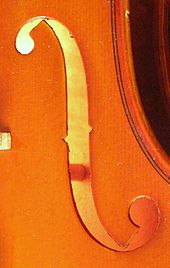Sound hole

A sound hole is a recess of any shape in a sound box to increase the volume of the instrument. The size, shape and position of the sound hole are very important for the sound of the instrument.
Instruments
Sound holes are most commonly found on stringed instruments such as the guitar , lute , violin and harp , but also on some percussion instruments (for example the block of wood and the cajón ). With some instruments (e.g. lutes) the sound holes are traditionally decorated with arabesque sound hole rosettes. With concert guitars, the sound holes are usually decorated and protected with mosaic inlays.
Special case: sound holes of an acoustic guitar from Ovation
C-hole
The C-hole is the older sound hole and historical string instruments such as the viols often have very ornate shapes.
F-hole
Better known is the F-hole on string instruments , which is reminiscent of the italic form of the lowercase letter . F-holes are located to the right and left of the bridge of the instrument. F-holes can also be integrated into the body of old guitar instruments, as well as today's archtop guitars, semi-resonance guitars , mandolins or ukuleles . The F-hole developed from the C-hole.
The C or F holes on instruments of the viol family and on viola d'amore are sometimes flame-shaped.





